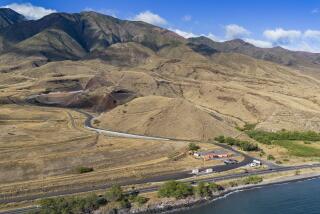A Recovery Takes Wing : Bald Eagle Shows Signs of Overcoming DDT in Return to Catalina
The endangered bald eagle, which disappeared from the Channel Islands decades ago because of illegal hunting and pesticides, is showing the first signs of making a comeback on Catalina--thanks to wildlife biologists.
In a long-awaited first for a pioneering eagle recovery project on the island, a young eagle laid a healthy egg on Catalina in March. The egg was taken from the nest and hatched in a laboratory incubator, producing a healthy chick that by November was back home flying in the wild.
It was an important moment for wildlife biologists, who for a dozen years have tried to re-establish the large, white-headed predators on the island by importing eagles, only to see them fail to reproduce. One problem has been the high levels of the pesticide DDT, which accumulates in their bodies and destroys the female’s ability to lay viable eggs.
But the arrival of a healthy egg gave them hope, and as it was being artificially incubated at a center at UC Santa Cruz, the female was given a healthy egg from Northern California to hatch and raise. This foster chick is also flying, proving that at least one nesting eagle could hatch and raise her young on Catalina Island.
When word of the success flashed across the federal and state wildlife recovery networks, the message was hopeful: If she can do it again, it could be a sign that DDT’s grip on the eagles may be broken.
“Getting a viable egg is significant. It suggests that conditions are improving out there,” said eagle expert Philip Schempf, chief of predatory bird management in Alaska for the U. S. Fish and Wildlife Service. “And it’s a good sign when a pair of eagles can raise a young bird there.”
The female that produced the good egg is named Wray and is from British Columbia. Captured as a fledgling specifically for resettlement in 1986, she was raised on Catalina and set free, one of three dozen birds introduced to the island by the Institute for Wilderness Studies. Only 14 remain on the island.
The five nesting pairs on Catalina produced eight eggs this spring. Each was taken to the University of California’s Predatory Bird Research Group laboratories in Santa Cruz for incubation. Only one hatched.
“One good egg is a very good sign, but we have to be cautious here, wait and see what happens next,” said Dave Garcelon, 37, founder of the Institute for Wilderness Studies and director of the Catalina recovery project.
The nonprofit institute, based in the Northern California city of Arcata, is funded by donations, grants and government contracts. It has spent $400,000 trying to re-establish eagles on the island.
Wray laid two eggs this spring, but only one hatched. Experts say this is not uncommon even among healthy birds. But instead of replacing her eggs with plastic decoys, as is normally done, Garcelon decided to put a single, viable Northern California egg in her nest.
Ten days after Wray’s chick hatched in the university incubator, it was put in a nest with foster parenting eagles in the San Francisco Zoo. Seven weeks later, the eaglet was brought back to the island.
Initially, such eaglets are raised in special cages built on high platforms in the remote, rugged island outback. They are never allowed to see their captors, even at feeding time. When they are ready to fly, the cage doors open and the birds are free to take off on their own.
Through the spring and summer, Garcelon and his crew parented Wray’s natural chick and two imported eaglets on the platforms, while Wray took care of her foster chick in the wild nest. By fall, all four fledged and took off on their own, testing their wings.
Adolescent eagles will remain in the area for several weeks, returning to the nest--or the platform--when they are hungry. But when they begin to hunt on their own they may head for parts unknown. It is not unusual for them to stay away for a year or longer, then return when they are ready to mate, he said.
“Wray’s chick stayed around for a while,” Garcelon said. “We saw it in November, then it was gone.” All four young eagles took off about that time. Wray’s foster eaglet returned and is establishing itself on the island.
The other three did not return, and at least one has died--killed by a car as it scavenged meat on a highway in Nevada. Officials learned of the death because the bird had been tagged with an identification band.
Even before Wray laid the healthy egg, experts were giving the Catalina eagle recovery project high marks. The program, which Garcelon started in 1980, has pioneered recovery techniques that have been adopted in other areas.
“They’ve been a great stimulus to the bald eagle recovery programs all over the country,” said Brian Walton, coordinator of UC’s predatory bird research programs.
Bald eagles prey on small birds, often killing them in midair. Eagles also kill fish, but often let gulls or pelicans catch the fish, then attack the smaller birds, forcing them to give up their catch or die.
Eagles build huge stick nests on cliffs or in the tops of gnarled trees on the bluffs overlooking the ocean. Each breeding season, roughly February through March, Garcelon and his staff spend weeks in the wild, watching the nests.
Like peregrine falcons and California brown pelicans, bald eagles were nearly wiped out in the 1940s and 1950s by DDT. Even now, 20 years after DDT production was banned, pesticide residues still show up in the fish and birds that are the eagle’s primary diet.
Minute traces of DDT in female eagles are enough to deplete their calcium production and weaken the eggshells. Most eggs are crushed in the nest, and those not broken seldom hatch.
The population of bald eagles in California had dropped to 20 nesting pairs by the time the birds were listed as an endangered species 25 years ago. Since then, the number has increased to 100 pair, most of them in Northern California.
Because of the heavy DDT pollution in waters off Palos Verdes Peninsula, re-establishing eagles in the coastal islands had been dismissed until Garcelon revived it. The last nesting eagles had been seen on Catalina in the late 1940s. Unable to reproduce, they disappeared.
When he started the project, Garcelon had a difficult time persuading government officials that they should give him permits to capture young Canadian eagles and introduce them to Catalina. They thought the effort would fail.
Then Wray laid her egg.
She is expected to mate again this spring, but will not be allowed to hatch her own eggs yet. The eggs will be taken to Santa Cruz for incubation.
“We want to give her another year to see if there is any DDT buildup in her system before we let her incubate her own eggs,” Garcelon said.
If all goes as hoped, she will be a full-fledged mom by 1993 and Catalina eagles will be on the way to recovery.
More to Read
Sign up for Essential California
The most important California stories and recommendations in your inbox every morning.
You may occasionally receive promotional content from the Los Angeles Times.





